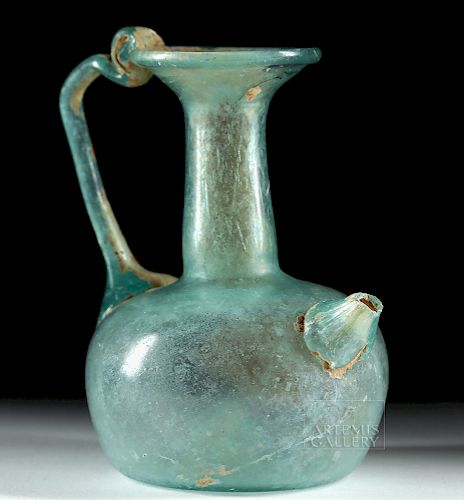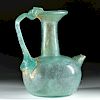Roman Glass Pouring Vessel w/ Spout
Lot 81d
About Seller
Artemis Fine Arts
686 S Taylor Ave, Ste 106
Louisville, CO 80027
United States
Selling antiquities, ancient and ethnographic art online since 1993, Artemis Gallery specializes in Classical Antiquities (Egyptian, Greek, Roman, Near Eastern), Asian, Pre-Columbian, African / Tribal / Oceanographic art. Our extensive inventory includes pottery, stone, metal, wood, glass and textil...Read more
Categories
Estimate:
$1,500 - $2,000
Absentee vs Live bid
Two ways to bid:
- Leave a max absentee bid and the platform will bid on your behalf up to your maximum bid during the live auction.
- Bid live during the auction and your bids will be submitted real-time to the auctioneer.
Bid Increments
| Price | Bid Increment |
|---|---|
| $0 | $25 |
| $300 | $50 |
| $1,000 | $100 |
| $2,000 | $250 |
| $5,000 | $500 |
| $10,000 | $1,000 |
| $20,000 | $2,500 |
| $50,000 | $5,000 |
| $100,000 | $10,000 |
| $200,000 | $20,000 |
About Auction
By Artemis Fine Arts
May 10, 2018
Set Reminder
2018-05-10 10:00:00
2018-05-10 10:00:00
America/New_York
Bidsquare
Bidsquare : Fine Ethnographic / Asian / Ancient Art
https://www.bidsquare.com/auctions/artemis-gallery/fine-ethnographic-asian-ancient-art-3213
Featuring antiquities from around the world including Pre-Columbian, Tribal, Classical, Asian, so much more! Artemis Fine Arts info@artemisfinearts.com
Featuring antiquities from around the world including Pre-Columbian, Tribal, Classical, Asian, so much more! Artemis Fine Arts info@artemisfinearts.com
- Lot Description
Roma, Imperial Period, ca. 1st to 3rd century CE. A gorgeous, free-blown glass vessel with a pale turquoise coloration. The vessel has a concave base with a rough pontil, an apple-shaped body, rounded shoulders, a gently-tapering cylindrical neck, and a flared rim with a rolled lip. An applied sinuous handle arches between the shoulder and rim, allowing it to be easily positioned when pouring. A short conical spout projects from the body opposite the handle, and was applied after the body's initial form had been created. While this vessel was likely meant for pouring scented oils, it may perhaps have been a baby feeder based on the dramatically-tapered design of the spout. Faint silver and rainbow iridescence envelop the exterior surfaces and add a splash of color to the vessel's muted blue-green hue. Size: 3.25" W x 3.5" H (8.3 cm x 8.9 cm).
Roman glass was of a high quality, both aesthetically and technically, for this early time period. While glass making had been practiced for centuries, the Romans invented glass blowing in the 1st century BCE which revolutionized the artform. We can appreciate such a wide variety of forms and shapes, because the medium of glass has unique physical properties that make for so many more possibilities than metal or clay. Roman glassmakers reached incredible artistic heights with both free-blown vessels and mold blown forms and decorations.
Provenance: private East Coast, USA collection
All items legal to buy/sell under U.S. Statute covering cultural patrimony Code 2600, CHAPTER 14, and are guaranteed to be as described or your money back.
A Certificate of Authenticity will accompany all winning bids.
We ship worldwide and handle all shipping in-house for your convenience.
#133096Loss to tip of spout. Surface wear commensurate with age as expected, small nicks to rim, handle, body, and base, and some minor abrasions, otherwise excellent. Nice earthen deposits as well as faint silver and rainbow iridescence throughout.Condition
- Shipping Info
-
All shipping is handled in-house for your convenience. Your invoice from Artemis Gallery will include shipping calculation instructions. If in doubt, please inquire BEFORE bidding for estimated shipping costs for individual items.
-
- Buyer's Premium



 EUR
EUR CAD
CAD AUD
AUD GBP
GBP MXN
MXN HKD
HKD CNY
CNY MYR
MYR SEK
SEK SGD
SGD CHF
CHF THB
THB

















